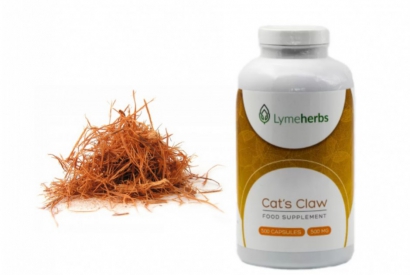
Cat's Claw
Cat's claw (Lat. Uncaria tomentosa) is one of the three herbs from the basic Buhner protocol used in the treatment of Lyme disease. Its main activity is modulation of the immune system. The herb also exhibits anti-inflammatory properties. Cat's claw belongs to the Rubiaceae family. It grows in the jungle in the form of a forest vine, often of considerable size. It wraps around trees and climbs upwards towards the sun, and owes its name to the protruding, hooked thorns on the vine.
Properties:
Cat's claw along with Japanese knotweed (Lat. Polygonum cuspidatum) and Andrographis (Lat. Andrographis paniculata), comprises the basic protocol for treatment of Lyme disease according to Stephan Buhner. It is characterized by a broad spectrum of activity, including anti-inflammatory, analgesic, antidepressant, antiviral, anticoagulant, detoxifying and many other properties. When treating Lyme disease, it is especially valued for:
• strengthening and stimulating the immune system
• demonstrating anti-inflammatory activity
• strengthening the central nervous system
• in case of chronic infection, increasing the levels of CD57 white blood cells, which in turn helps to inhibit the progression of the disease
• use in cognitive disorders
• showing specific anti-inflammatory effects in the treatment of joint and muscle pain in Lyme disease, reducing swelling
• modulating the functioning of the immune system
• acting as a general tonic for the body
• is an HLA-DR modulator
• relaxing the central nervous system
• increasing well-being
• showing an analgesic effect
Form of the herb:
The herb is sold in several forms:
1. Alcohol based tincture
Alcohol-based plant tincture is made by macerating a fresh plant in full alcohol or a dried plant in a mixture of alcohol and water. Alcohol is an excellent medium for extracting herbs, and alcohol-based tinctures are the most popular form of herbal use by professional herbalists. Maceration of herbs with alcohol ensures that the active ingredients of the herb are delivered to the bloodstream faster, making the tincture a fast-acting form of taking the herb.
2. Alcohol-free extract
Non-alcoholic tincture is prepared primarily on the basis of glycerin. Glycerin has become a popular alternative to alcohol tinctures and is perfect for children and people who don't like or can't drink alcohol. However, glycerin is not as effective in extraction as water or alcohol. Glycerin only has about 60% of the alcohol extraction value. Cat's claw glycerate will therefore be 40% weaker than alcohol tincture.
3. Encapsulated herb
Capsules have become a very popular way to take herbs because they are an easy and convenient dosage form. One of the main advantages of the capsules is that we do not feel the taste of the herbs. Additionally, when taking the herb in the form of a ground herb enclosed in a capsule, you consume all the plant material along with the plant fibers. However, remember that along with the ground cat's claw in the capsule, you also swallow the capsule shell. The capsule shell does not contribute anything to the therapy and must be digested by the body. If you follow Buhner’s Protocol you would need to take large amount of capsules. For people with weakened digestive system, this can be problematic after prolonged use of herbs.
4. Ground herb
Ground Cat's claw can be taken directly, encapsulated or made into tinctures. The downside of taking ground herb is the taste.
Direct use: add 1 teaspoon of herb to a glass and pour lukewarm water, stir and drink the liquid with sediment. In order to improve the taste you can then add a little honey and lemon juice.
Making tinctures at home: At home, it will be easiest for you to prepare a tincture in a concentration of 1: 5, i.e. 1 part of dried cat's claw to 5 parts of alcohol. Alcohol should be diluted with water due to the fact that plants lose their natural moisture during drying. When making tinctures of a dried plant, add as much water as the plant would contain if it were fresh. Then pour the herb with alcohol (50-60%) and then leave it for maceration for 2 weeks in a dark vessel without access to light. Shake the jar once per day. After 2 weeks, the macerate should be filtered. Store the finished macerate in a dark bottle or an ordinary bottle wrapped in aluminum foil in a place protected from access to light.
5. Cut herb
Cut herb is a dried form of a cat's claw cut into smaller pieces. You can prepare decoctions or tinctures from the cut herb.
Decoction: Pour 7 g of Cat's Claw into 1 liter of water and boil for 20 minutes over low heat. Strain and leave to cool. Divide the decoction into portions and drink during the day.
Side effects:
High doses of this herb can sometimes cause intestinal disorders such as loose stools, diarrhea and / or abdominal pain. These symptoms tend to disappear with prolonged use. If symptoms occur, the dose should be reduced. If diarrhea lasts more than three days, the use of the herb should be discontinued.
Contraindications:
Cat's claw cannot be taken by people taking preparations for lowering blood density. People who are scheduled to have surgery must stop taking the herb 10 days before any surgery. You cannot take the preparation during treatment with drugs that inhibit the secretion of gastric acid, because they can also inhibit the transformation of this herb into its active form in the stomach. Cat's claw should not be be used by pregnant or lactating women.

 Boosting Your Libido Naturally with Herbal Supplements
Boosting Your Libido Naturally with Herbal Supplements
 Unlocking Energy Potential: Shilajit's Impact on ATP Production and Vitalit
Unlocking Energy Potential: Shilajit's Impact on ATP Production and Vitalit
 Collagen's Role in Lyme Disease Recovery: Understanding Its Vital Benefits
Collagen's Role in Lyme Disease Recovery: Understanding Its Vital Benefits
 Helicobacter Pylori- Natural Treatment
Helicobacter Pylori- Natural Treatment
 Sleep and Immunity
Sleep and Immunity